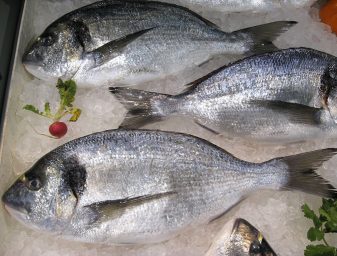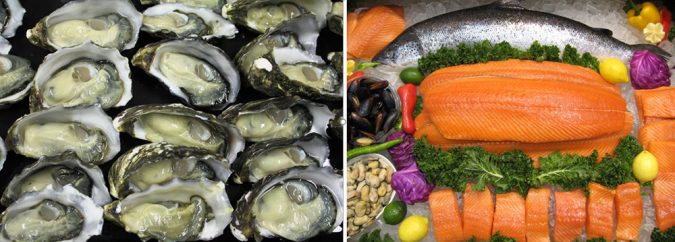As global health organizations fail to educate, medical practitioners must lead the way

Mention was made in the last article ‘COFI 32 presents an opportunity to promote seafood’ that it took 41 sessions (that would be over 41 years) of The Committee on World Food Security (CFS) to finally get fish/seafood on the agenda. At the FishAdapt – Global Conference on Climate Change Adaptation for Fisheries and Aquaculture held in Bangkok 8-10 August 2016, we learned that fisheries and aquaculture struggle to get a seat at Global Climate Change table despite the knowledge of the importance of the ocean when it comes to that subject.
In the same vein, it was not until 2012 that the United Nations’ Food and Agriculture Organisation (FAO) convinced the Organisation for Economic Co-operation and Development (OECD) that there needed to be a Fish Price Index as part of the Global Food Price Index. FAO have recently moved staff to OECD’s Paris office to cement the relationship into the future. In Australia and many other countries, we know that many of the important National Food Committees fail to even acknowledge seafood.
Bearing in mind seafood is the most traded food commodity, bar none, according to World Trade Organisation (WTO), then you have to say either seafood is not stepping up to the plate or that the various groups are so stuck in the past that they have failed to even consider seafood as an essential food.
Seafood was actually on the agenda in a positive way at the Second International Conference on Nutrition (ICN2) in November 2014, specifically “The Contribution of Fisheries and Aquaculture to Improved Nutrition.” Delegates at that event were reminded that: “by adopting the Rome Declaration and the Framework for Action at the ICN2, world leaders renewed their commitments to establish and implement policies aimed at eradicating malnutrition and transforming the food systems to make nutritious diets available to all. Fisheries and aquaculture can play a critical role in global food security and nutrition. FAO has embarked on a number of activities to support countries to improve their fisheries and aquaculture sectors and to develop local fish production, create employment, and linking fishery products to markets. Fisheries and aquaculture provide a unique window of opportunity for ICN2 follow-up towards achieving healthy diets.”

We also know that the importance of seafood in the diet is not being understood by all medical practitioners. It is essential that specialists dealing with important areas of heart health and women’s health become well informed with all the latest information. One important person has responded to this recently.
Diet and heart disease article
Dr. Dariush Mozaffarian M.D., FACC is an American cardiologist, epidemiologist and the dean of the Gerald J. and Dorothy R. Friedman School of Nutrition Science and Policy at Tufts University, having previously founded the Harvard School of Public Health school’s program in Cardiovascular Epidemiology. A few months ago he published the paper, “Diet and Heart Disease – What Every Cardiologist Should Know,” which attracted some attention.
In this paper, Dr. Mozaffarian said: “Throughout my training as a cardiologist, from medical school through fellowship, it became increasingly clear that the single major cause of poor health in my patients was poor diet. Yet, like my fellow medical students, house staff, and attendings, I had received very little relevant training in nutrition, lifestyle, or effective behavior change strategies. I could perform and interpret a dizzying array of technologically-based diagnostic tests and interventions, but I had not been given the tools to address the root causes of my patients’ illnesses and distress. Remarkably, I faced my patients every day with only a subset of the full complement of necessary information and approaches to improve their health.”
So many of our health practitioners are under pressure today because of increased chronic diseases and budgetary constraints. There is little time for them to do the homework necessary so we need to be able to find a way to be able to help. In Dr. Mozaffarian’s own words “The disconnect between what we know versus what is being done in nutrition is larger than for anything else in health care. Although this presents a remarkable irony, it also presents a remarkable opportunity to reduce disease and rein in spiraling health care costs.”
To prove this point a good friend visited his cardiologist recently and he was told to eliminate shrimp/prawns from his diet due to the high cholesterol, whereas we well know that this is just mostly a myth (see Advocate article “Facts about shrimp and cholesterol).
Cardiologists should lead charge
Dr. Mozaffarian suggests that cardiologists should be leading this charge. He points out that cardiac disease, stroke, and their related metabolic disorders and risk factors represent eminently preventable conditions that together consume a substantial proportion of national health resources.
He added: “We are at the front lines of this battle, and we must maximally utilize every defense in our arsenal to make a difference in our patients’ lives. Recognizing this, the American Heart Association formally prioritized lifestyle and behavior change in its 2020 Strategic Impact Goals: the mission is no longer just about treating or even preventing disease, but achieving health. I was fortunate to participate in the writing of these goals, particularly by contributing to the dietary targets, which appropriately focus on food-based priorities such as increasing fruits, vegetables, seafood, and whole grains, and reducing sugar-sweetened beverages and a pernicious additive, sodium.”

In the summer of 2015, the American College of Cardiology (ACC) held its first-ever Population Health Retreat, aiming to shift the ACC’s paradigm away from disease recognition and management and toward prevention: healthier lifestyles, improved nutrition, and greater physical activity. ACC President Kim Allan Williams, Sr., MD, FACC, highlighted this new focus and declared, “We have to become life coaches and good examples of healthy lifestyle in order to promote lifestyle improvement.”
By understanding this set of priorities, cardiologists and other allied health professionals can appropriately guide teaching and behavior change efforts. On many occasions we have made the same call relating to fish retailers and how, if they were trained on understanding the various health benefits of the various species of seafood, that would create a consistent approach and go some way to creating more informed consumers. For a successful transformation towards successfully addressing diet and behavior, what should every cardiologist know?
Four aspects to the plan
Dr. Mozaffarian suggests there are four particular aspects to the plan:
- Get up to date information – Historical prioritization on reducing total fat, saturated fat and dietary cholesterol is outdated and incomplete. There is now so much evidence from a broad range of research paradigms demonstrating that the focus should be on healthful food-based diet patterns, including increased intakes of beneficial foods such as fruits, nuts, vegetables, minimally processed whole grains, legumes, polyunsaturated and phenolic-rich vegetable oils, seafood, yogurt; and reduced intakes of sugar-sweetened beverages, processed (preserved) meats, and foods rich in refined grains, starches, and sugars. Red meats should be consumed moderately to prevent weight gain and diabetes, and butter used occasionally but not emphasized. Two industrial additives – sodium and partially hydrogenated vegetable oils – should also be avoided.
Such a diet meaningfully lowers total carbohydrate, due to less refined carbohydrates, and increases total fat – optimally exceeding the previously recommended cap of 35 percent of calories – due to increased nuts, fish, and vegetable oils. However, these macronutrient changes reflect a secondary consequence, not primary aims, of the food-based priorities.
- Become a champion of quality – cardiologists should be champions of the distinction between diet quality versus quantity. “Poor diet” and “obesity” are neither synonymous nor interchangeable concepts. Healthful diet patterns operate through numerous mechanistic pathways and risk factors, with obesity representing only a small subset of these pathways. Regardless of body weight, healthful diet patterns substantially reduce cardiovascular risk, while also stabilizing long-term weight gain. Thus, diet quality, rather than weight and adiposity, should be the primary focus of dietary counseling.

Indeed, focus on calorie-counting can lead to paradoxical and potentially harmful recommendations. Every calorie in a food is thermodynamically equivalent in a test tube. Yet, different foods produce complex and divergent effects on the physiologic compensatory mechanisms for long-term energy balance. For long-term weight equilibrium, foods rich in rapidly digestible, low-fiber carbohydrates appear particularly adverse, while fruits, non-starchy vegetables, nuts, yogurt, fish, and whole grains appear protective. Of course, for short-term weight loss, calories are king: this explains why nearly any diet can be effective in the short-term. Many overweight and obese patients effectively lose weight on very low-carbohydrate diets, a reasonable first choice for intensive short-term weight loss, especially among patients with insulin resistance. Once weight loss has been achieved, patients should shift back toward healthful, food-based diet patterns.
- Understand behavior change – cardiologists must make themselves familiar with effective behavior change strategies and vigorously advocate for health care system improvements to facilitate these efforts. Successful behavior change methods incorporate shared goal setting, self-monitoring, feedback, scheduled follow-up, and peer support. These provider efforts must be potentiated by changes to health systems, including regular clinician training, coordinated care by multi-disciplinary teams, electronic health records that assess and monitor diet, electronic systems for patient feedback and regular follow-up visits, and restructuring of reimbursement guidelines, practice goals, and quality benchmarks to include nutrition.
In the United States the Affordable Care Act’s provisions, whereby medical groups, physician-hospital organizations and integrated delivery systems will share medical and financial responsibility for the health of populations, provide a further incentive to align priorities toward nutrition and behavior change. Potentially novel internet, mobile and personal technologies may be effective and complement clinical efforts, but additional research needs to confirm this.
- Show leadership – cardiologists and their professional societies should be actively leading our communities and our nations toward evidence-based policies and quality standards that protect the public and shift the population toward health, just as we have done for automobile safety, drug safety, air and water quality, worksite safety, building construction standards, food-borne pathogens and tobacco smoking. A handful of sensible dietary policies and quality standards would produce major health benefits across the population while also reducing inequities in nutrition and health. Such “soft healing” efforts are crucial complements to the current “hard healing” focus of modern health care and also help to address disparities in knowledge, cost, and access.
So, in perspective, much more successful could our industry be if we were able to find pathways to link the how above with our knowledge on seafood?
At the upcoming American Aquaculture (19-22 February 2017 in San Antonio, Texas) we will be running a session titled, “Promoting Seafood Consumption: A Tool for Improving Nutrition, Health and Regional Development – Public Policy and Producers effort.” If you wish to contribute, please either put in your abstract as soon as possible or contact me directly.
Now that you've reached the end of the article ...
… please consider supporting GSA’s mission to advance responsible seafood practices through education, advocacy and third-party assurances. The Advocate aims to document the evolution of responsible seafood practices and share the expansive knowledge of our vast network of contributors.
By becoming a Global Seafood Alliance member, you’re ensuring that all of the pre-competitive work we do through member benefits, resources and events can continue. Individual membership costs just $50 a year.
Not a GSA member? Join us.
Author
-

Roy D. Palmer, FAICD
GILLS
2312/80 Clarendon Street
Southbank VIC 3006 Australia
www.seafoodprofessionlas.org[109,111,99,46,108,105,97,109,103,64,100,121,111,114,114,101,109,108,97,112]
Tagged With
Related Posts

Intelligence
For healthy eating, we are what we allow
Many current eating habits have negative results for our health, lending credence to “you are what you eat.” Eating habits can be changed, and increasing seafood consumption can provide numerous health benefits, including as a significant source of critical micro-nutrients, vitamins and minerals. Seafood should have its own spot in our dietary food pyramid.

Intelligence
Facts about shrimp and cholesterol
Many people, including health-conscious consumers, are concerned about the cholesterol content of foods such as meat, eggs and dairy products. In the case of shrimp, the cholesterol story is different because a number of research studies have demonstrated that the high percentage of “good fats” in shrimp reduce the impact of cholesterol, and that a majority of people can eat shrimp as part of a balanced diet.

Intelligence
New normal in global nutrition?
The latest Global Nutrition Report indicates serious levels of both malnutrition and adult overweight and obesity. It is a major challenge, particularly among women and children. Seafood, including from aquaculture, can play a significant role in helping address this issue.

Intelligence
Doctors: Place a greater value on seafood consumption
Many important organizations around the world fail to acknowledge the importance of seafood to human health and well-being. There is a disconnect between what we know regarding the benefits of seafood and what is being done to acknowledge these benefits and increase seafood consumption in nutrition.


